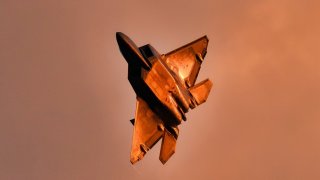F-22 Raptor: A "Beast" Without a Beast Mode
"Beast mode" refers to a fighter jet carrying an unusually heavy load of weapons. The F-35 Lightning II has a "beast mode," allowing it to carry up to 22,000 pounds of munitions, about four times its standard load. This configuration is intended for "Day Three" operations, after air superiority and enemy air defenses are secured.
Summary and Key Points: "Beast mode" refers to a fighter jet carrying an unusually heavy load of weapons. The F-35 Lightning II has a "beast mode," allowing it to carry up to 22,000 pounds of munitions, about four times its standard load. This configuration is intended for "Day Three" operations, after air superiority and enemy air defenses are secured.
-The F-22 Raptor, while not having a "beast mode," is still considered a formidable "Day One" fighter due to its advanced stealth and maneuverability.
-It’s envisioned as an escort for bombers like the B-2 and B-21 in initial combat phases, making way for the F-35 to use its "beast mode." Some pilots describe the F-22 as a "beast" on its own due to its agility and combat capabilities.
F-35's "Beast Mode" vs. F-22 Raptor: Aerial Powerhouses Compared
While “beast mode” is a description, not a technical term, it refers to a fighter plane that is carrying more than its usual or standard array of weapons.
The F-35 Lightning II does have a weapons-heavy beast mode that has around four times the ordnance of regular stealth mode or 22,000-pounds of munitions.
Meanwhile, the F-22 Raptor is more reliant on its basic stealth technology for training in “high-end combat scenarios.”
The F-22 does not have a beast mode like the F-35, according to a search of open-source defense news, but the Raptor is considered by some pilots to be a “beast” in aerial combat all the same.
The Air Force was even proud enough to feature the F-22 in a recruiting ad that runs before Hollywood’s new Top Gun sequel.
What Is Beast Mode?
Beast mode is envisioned by Air Force war planners to be a “Day Three” attack configuration in an offensive operation.
This means the F-35 would drop or fire extra ordnance after the Air Force and Navy first acquires air superiority and achieves suppression of enemy anti-aircraft defenses.
The F-35 would have extra bombs and missiles loaded on hardpoints under its wings – less stealthy, but more powerful.
The F-22, due to its highly-maneuverable stealth airframe, is envisioned as a “Day One” fighter that could escort the B-2 bomber or, someday, the B-21 bomber on the first day of conflict, penetrate radar and destroy enemy surface-to-air missiles to clear the way for F-35 beast mode.

Rehearse Likely Offensive Scenarios Early in a Conflict
The Air Force and Navy have practiced this type of attack configuration before and the concept of operations is something that could become a standard order of battle in a future conflict in East Asia.
Some Pilots View the F-22 in Wonder
The F-22 itself is a flying marvel according to some aviators.
A few years back, Task and Purpose web magazine shared pilot reactions from an interview on a podcast. Retired Air Force Colonel Terry “Stretch” Scott flew the F-22 during his career and related how potent the airplane is. “The flight controls … are phenomenal,” Scott said. “The original operator’s manual actually read ‘you may fly this aircraft with reckless abandon,’” he recalled.
The agility of the Raptor Is Unforgettable
“Having come from a fourth-generation background, it’s eye-watering how nimble the jet is,” said Scott, a former F-15 pilot. “Even when I’m flying offensive against another Raptor, that airplane is eye-watering when it starts maneuvering visually.”
The F-22 Is Beast Mode
So, according to these Air Force pilots, the F-22 is always a “beast” due to its stealth characteristics and maneuverability. It’s good the Air Force envisions working as a team with F-35s and stealth bombers.
The Day One – Day Three designation is interesting and shows the military is planning for a hard-to-kill enemy defense configuration.
About the Author: Brent M. Eastwood
Brent M. Eastwood, PhD, is the author of Humans, Machines, and Data: Future Trends in Warfare. He is an Emerging Threats expert and former U.S. Army Infantry officer. You can follow him on Twitter @BMEastwood.
Image Credit: Creative Commons.


